Sherlock Holmes and the Cottingley Fairies
How Two Young Girls Fooled the World, Including Sir Arthur Conan Doyle
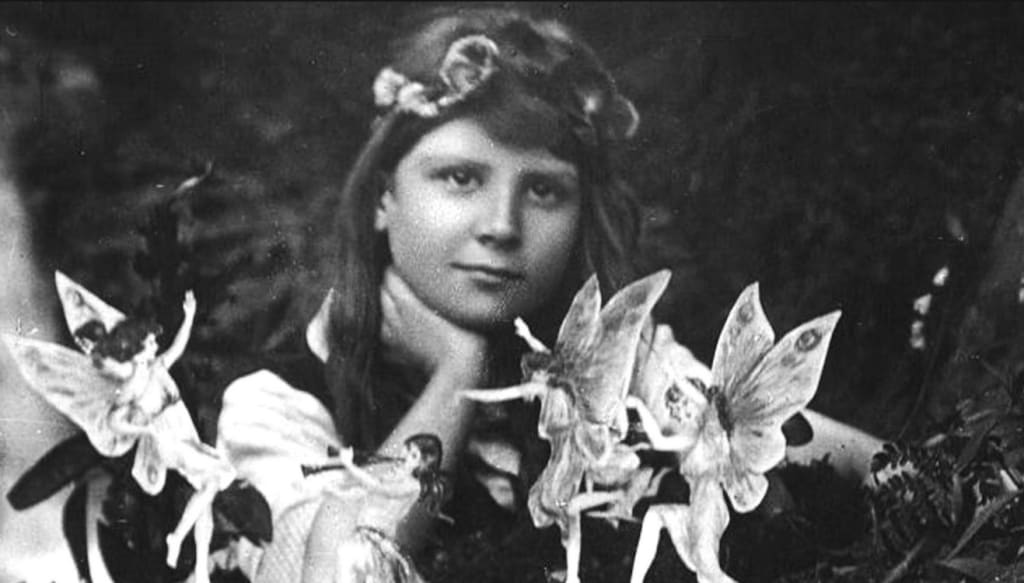
Over a hundred years ago, in the small village of Cottingley, England, two young girls embarked on a silly prank that led thousands to believe in magic. It would not be fully debunked for over sixty years.
The Cottingley Fairies
It was the summer of 1917. Nine-year-old Frances Griffiths and her mother returned from South Africa to stay with relatives in Cottingley, West Yorkshire. Right next door were Polly and Arthur Wright, and their sixteen-year-old daughter, Elsie Wright.
The two girls, who were cousins, became fast friends, despite the age difference.
One of their favorite places to play was Cottingley Beck, a stream that ran through a mossy glade in the woods behind the garden.
The girls were often scolded for coming home with wet clothes, and one day, decided to blame it on “the fairies who lived in the beck”.
Of course, the excuse was scoffed at.
Whether it was from boredom or as a way to wiggle out of punishment, Elsie and Frances decided to borrow Arthur Wright’s Midg quarterplate camera, and returned home one September day claiming they had photos of the fairies.
Arthur Wright was an amateur photographer, with a darkroom of his own. He knew his sixteen-year-old daughter had knowledge of photography, and she was smart and savvy. When he saw the first five photographs of the Cottingley fairies, he was dismissive, remaining unconvinced.
The girls, however, kept insisting the pictures were real and that the fairies lived by the creek.
Arthur suspected the girls had used some sort of cutouts and posed them, but he could not figure out where the models had come from, as there were no such images of fairies in either family’s possession.
Still, he brushed the matter off, and that would have been the end of it.
---
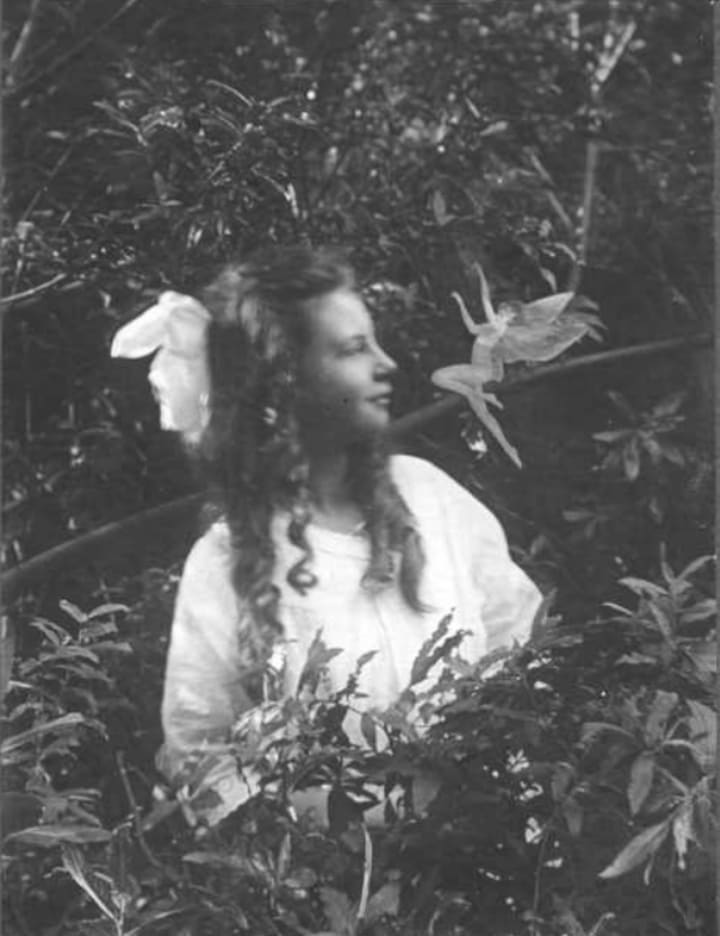
Three Years Later
Polly Wright, Elsie’s mother, was more susceptible to believing in the unexplained. She thought the fairies might be real. She had an interest in metaphysics and the supernatural, and in 1920 she attended a meeting of the Theosophical Society in a nearby town.
The subject of the lecture was “fairy life”, and Polly brought the photos, curious to get an outsider’s opinion.
Edward Gardner was the Theosophist who had led the lecture. The message he was intent on spreading was this:
“Humankind was undergoing a process of transformation that would eventually lead to the perfection of the species.” -Edward Gardner
When Gardner saw the fairy photos, he decided this was the proof he needed. To him, the existence of fairies, and the fact that they were letting themselves be photographed by humans, meant that great metaphysical changes were about to happen.
The girls’ prank was about to snowball out of control.
---
Sir Arthur Conan Doyle
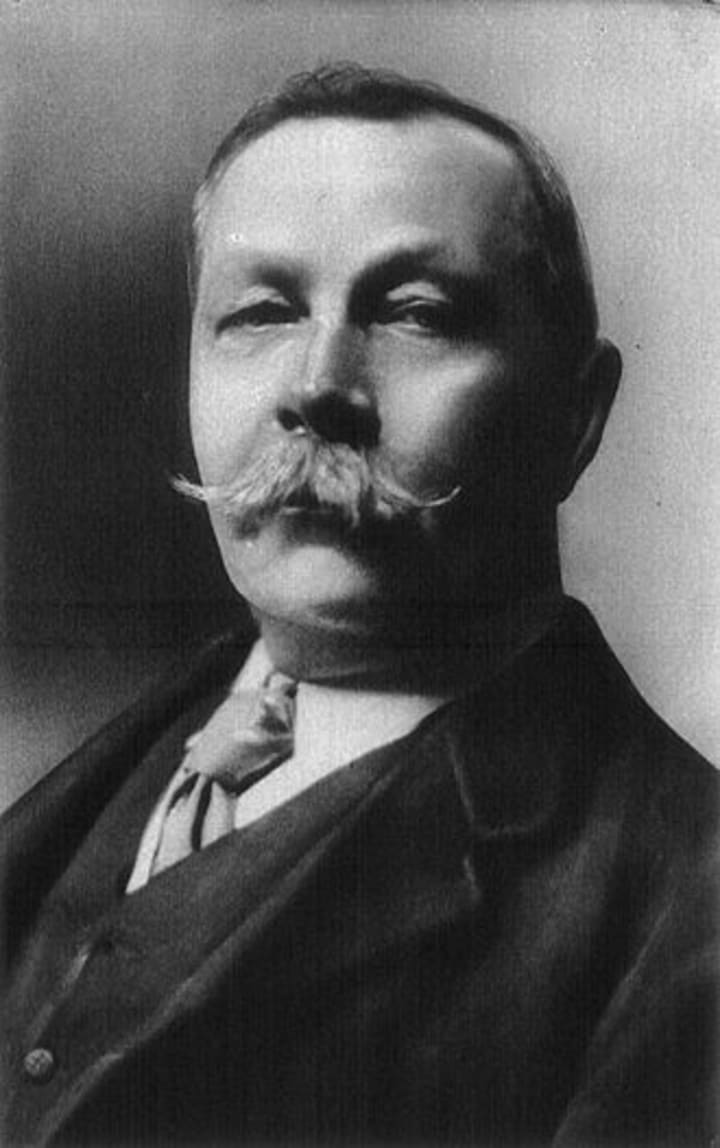
In early December of 1920, Sir Arthur Conan Doyle, himself a believer in spiritualism, was writing an article about fairies to feature in the Christmas issue of his magazine, The Strand (The Strand was also the first place he published a Sherlock Holmes detective story).
Edward Gardner had been using the five fairy photographs in his lectures, and he’d also had prints made up for distribution.
When Doyle saw prints of the fairy photographs in a spiritualism magazine, he was intrigued.
He obtained permission by the Wright and Griffiths families, and published the photos in The Strand, making them famous.
---
Skeptics
The photos were, of course, met with skepticism.
Critics attacked Doyle, who was enjoying quite a bit of fame for his Sherlock Holmes stories.
In an effort to maintain his reputation, he had the photos examined by a team of experts from the Kodak company. Photography was still a relatively new science, and the experts’ opinions were mixed.
Photography expert Harold Snelling finally dubbed the photos as untouched, but refused to speculate as to whether the fairies themselves were real.
“Authentic images of what was in front of the camera.” — photography expert Harold Snelling in 1921
Doyle took this as a victory, and ran with it. He instructed the girls to take more photographs, and so they did… producing three more fairy images by 1922. There were eight fairy photographs in all.
Sir Arthur Conan Doyle published the story and photos of the Cottingley Fairies in his 1922 book, “The Coming of the Fairies”, in which he stated:
“The recognition of their (fairies’) existence will jolt the material twentieth century mind out of its heavy ruts in the mud, and will make it admit that there is a glamour and mystery to life.” -Sir Arthur Conan Doyle
The little village of Cottingley was flooded with visitors, including a clairvoyant who visited the site and claimed she saw fairies everywhere.
It was too late for the girls to confess now. To do so, they risked bringing shame down on their families, and the destruction of Sir Arthur Conan Doyle’s reputation.
---
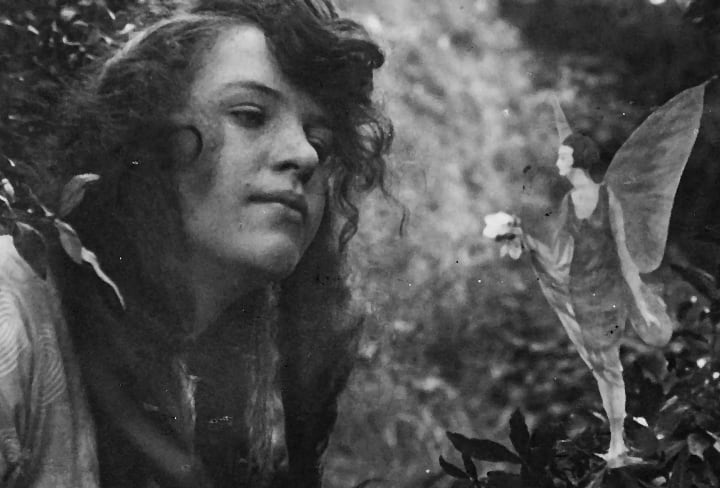
The Believers
Why was the world so ready to believe? In modern times, we look at these photographs and shake our heads, wondering how anyone was fooled. The fairies look very two dimensional, and yet, the photos were widely seen as authentic… for decades.
There may be several reasons.
- Photography still had an air of mystery surrounding it. Spirit photography (which was akin to a double exposure) was very popular at the time. People wanted to believe the camera could capture things invisible to the naked eye.
- Also, the world was ready for something magical, fresh out of the devastating war era of 1914–1918. Images of fairies, gnomes and other supernatural beings were immensely popular in the 20’s and 30’s, mass marketed as prints, pottery and ornaments. In the mid 1920’s, Walt Disney cartoons were just beginning to gain a foothold.
In short, the world wanted to believe in magical creatures.
---
The Truth
The fuss died down as time went by and the girls produced no more pictures. A few more articles were written, and Cottingley was still visited by tourists, though their numbers were waning.
Life moved on, and so did the world’s fascination with the Cottingley Fairies.
The British Broadcasting Corp. interviewed Elsie and Frances in the 1960’s, the 1970’s and even in the 1980’s, still trying to debunk the fantastic story of the Fairies of Cottingley Berk.
The girls stuck to their story, and no one could prove it was a hoax.
Sir Arthur Conan Doyle and Edward Gardner both went to their graves believing in the authenticity of the photographs.
Finally, in 1983, 66 years after the prank had made their village famous, the truth finally came out. Elsie and Frances were now in their seventies and eighties, and Elsie confessed.
The fairies were cardboard cutouts, beautiful drawings that Elsie had made, using illustrations from a book that was popular at the time, “Princess Mary’s Gift Book”, published in 1914.
Elsie had added wings, and this detail apparently was enough to mask the figures so that no one recognized their origin.
The girls had used hatpins to prop up the cutouts. The dot made by a hatpin can be seen in one photograph, on a fairy’s torso.
In his writing on the Cottingley Fairies, Sir Arthur Conan Doyle referred to the dot (made by a hatpin) as evidence that “fairies had navels, and therefore gave birth just as humans did”.
Still Famous
A revival of fairy believers occurred after Frances Griffiths partially recanted her hoax admission before she died, claiming that one (but only one) of the first five photographs was, indeed, real. Her daughter, Christine Lynch, has also made public her own view that the fairies of Cottingley Berk really did exist.
Two films were made in 1997, inspired by the hoax. “Fairy-Tale A True Story”, and “Photographing Fairies”.
Two of the original Cottingley Fairy photographs were sold at auction in 2018, by Dominic Winter Auctioneers in Cirencester, England.
Alice and the Fairies, which shows Frances surrounded by four fairies, sold for £15,000 ($19,620)
Iris and the Gnome, which features a gnome dancing towards Elsie, sold for £5,400 ($7,062).
---
https://www.historic-uk.com/CultureUK/The-Fairies-of-Cottingley/
https://en.wikipedia.org/wiki/Cottingley_Fairies
https://encyclopedia2.thefreedictionary.com/Cottingley+Fairies
https://www.cnn.com/style/article/fake-fairy-photographs-auction-uk-intl/index.html
About the Creator
Shell St. James
Shell St. James is a New England author living in an 1895 farmhouse with her musician soulmate, feline muse, and a benevolent ghost. Her novel, "The Mermaid of Agawam Bay", is available on Amazon. Find out more at www.shellstjames.com

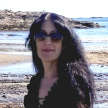





Comments
There are no comments for this story
Be the first to respond and start the conversation.